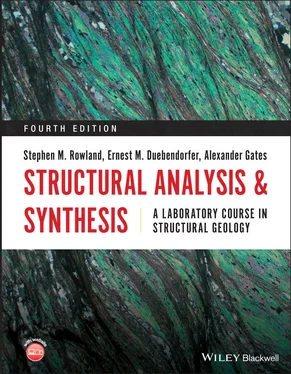One of the most challenging aspects of structural geology for introductory students is visualizing three‐dimensional structural features and objects and representing them or projecting them on two‐dimensional diagrams for analysis. This is still the case even with computer programs to solve simple to complex problems. Students are strongly encouraged to use props to help visualize the real‐world features rather than trying to imagine them. The exercises are much easier to solve and the methods understood using this approach.
The other challenge for students is that many techniques build upon previously learned techniques. It is imperative for students to complete the supporting exercises and fully understand them before moving to the next level of rigor, or the deficits will snowball. This is especially true with the equal‐area projections which are used in multiple chapters. For this reason, all of the exercises should be done manually at their introduction. After students master the manual techniques, they are encouraged to use computers.
The final challenge for which many students find problems is with the quantitative aspects. The quantitative requirements are not rigorous, but many students cannot remember basic trigonometric relationships, which are used extensively. Many exercises require only SOHCAHTOA and inverse functions for solution, but instead of sketching the geometry of the situation, many students try to imagine it and make errors. It is recommended that triangles are drawn and angles and sides labeled so errors can be avoided. Use of a protractor should also be reviewed prior to the class.
This is the fourth edition of the classic and popular laboratory manual in structural geology that was first introduced in 1986 by Stephen Rowland. Each edition follows trends in the field and this edition is no exception. It retains most of the exercises from previous editions, so that faculty who regularly adopt previous versions of the manual may continue to do so. There are minor changes to some chapters and the addition of several new chapters, but most chapters are composed of previous material that has been edited or expanded upon to adjust the focus and provide structural techniques that were not previously available.
The general changes include several themes:
1 Many geology graduates are employed in the environmental industry. Exercises have been adapted to include environmental applications as well as traditional techniques of structural geology.
2 Many of the exercises have been revised to be more quantitative, especially with regard to determining depth to subsurface features. Techniques are introduced for more quantitative analysis. Several computer programs are available to solve quantitative problems. Although students are taught to perform techniques manually, the computer programs are described and locations are provided.
3 Chapters and exercises that were primarily descriptive and overlapped strongly with lecture content of most courses in structural geology were revised to be more quantitative. This is especially true for stress and strain measurements. Although many strain techniques were developed several decades ago, they provide necessary quantitative constraints on processes and relationships to make them realistic. This manual includes several additional quantitative techniques.
4 All quantitative techniques have limitations. Without certain requirements and assumptions, the techniques will not yield useful results. It is important that students understand these limitations so they can appropriately apply the techniques and properly evaluate their trustworthiness.
5 Many techniques of structural geology, both in the field and in the lab, are better taught through visual demonstration. Even with classroom demonstration, students require individual demonstration, which is very time‐consuming for the professor. Online videos are few and incomplete. This edition includes accompanying videos to demonstrate complex techniques.
6 Figures for the Problems are now included on separate pages at the end of each chapter and labeled with a “P” in the text for ease in identifying and locating them.
7 With limitations on accessing appropriate structural field locations from many urban areas and schools in areas with inappropriate geology, structural geology field trips must be eliminated from the curriculum. In addition, students with physical disabilities and illnesses may be limited in access to field locations. For these reasons and other possible restrictions, two virtual field trips from classic structural geology areas have been added to the manual. These virtual field trips are made from the perspective of a student making observations and measurements in the field. There are even erroneous measurements included so students will need to evaluate and eliminate them.
Many of the ideas in this revision have been refined during the offering of structural geology courses since the late 1980s. However, the direct influence of structural geology faculty members including James Granath, David Gray, Carol Simpson, and David Valentino is acknowledged in this revision. In addition, Richard Allmendinger and Frederick Vollmer provided guidance and permission to reference their excellent computer programs available on their websites. The influence of Ben van der Pluijm and Stephen Marshak is also acknowledged.
About the Companion Website
This book is accompanied by a companion website:
www.wiley.com/go/structuralanalysis4
The website includes:
Powerpoints of all figures from the book for downloading
Web links from the book for downloading

1 Attitudes of Lines and Planes
Objectives
Measure planes and lines in the field using standard techniques.
Become familiar with the azimuth and quadrant methods for defining the orientations of planes, lines, and lines within planes.
Draw and read back orientations on maps.
This chapter investigates the orientations of lines and planes in space. The structural elements that we measure in the field are lines and planes, and analyzing them on paper or on a computer screen helps us visualize and understand geologic structures in three dimensions. In this chapter, we examine nomenclature, measurement, and representation of these structural elements. Solving apparent‐dip problems is commonly also included in a chapter on lines and planes, but these problems are much more easily solved using a stereonet and will be included in Chapter 3.
All orientations contain two components: an inclination and a declination. The declination is a horizontal angle of rotation from a reference point, most commonly true north. Declinations include the strike of a planar feature ( Figure 1.1) and the trend of a linear feature ( Figure 1.2). Inclination is the angle that a plane or line is sloped relative to the horizontal plane of the earth’s surface. For planes, this quantity is the dip ( Figure 1.1), and for lines, it is the plunge ( Figure 1.2).
The orientation of planar features is measured with a strike and dip. By convention, they are labeled strike, dip, and dip‐direction, though there are variations. The dip direction is the quadrant toward which the dip is inclined. Dips must be perpendicular to their corresponding strike and are indicated by the dip direction. A northeast (NE) strike, for example, can only have a southeast (SE) or northwest (NW) dip direction. The orientation of linear features is measured with trend and plunge and is reported as plunge/trend. Lines do not require a dip direction, so the written orientation is readily distinguished from that of a plane.
Читать дальше












